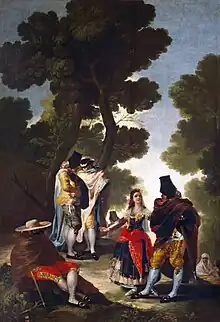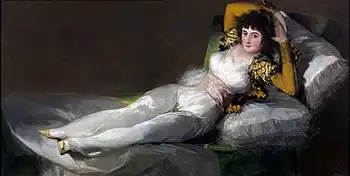Majo
Majo (masc., [ˈma.xo]) or maja (fem., [ˈma.xa]), also manolo and manola, after the most popular names, were people from the lower classes of Spanish society, especially in Madrid, who distinguished themselves by their elaborate outfits and sense of style in dress and manners, as well as by their cheeky behavior.[1] They flourished from the late 18th to early 19th century, and to some extent later. Majos and majas were one of the favorite subjects of some 19th-century Spanish painters.

The majos and majas outfits were exaggerations of traditional Spanish dress. The style stood in strong contrast to the French styles affected by many of the Spanish elite under the influence of the Enlightenment. Majos were known to pick fights with those they saw as afrancesados ("Frenchified" – fops).[2]
In Spanish, the word possesses derived forms such as chulapo and chulapa, a version of chulo and chula in reference to their saucy attitude, as well as chispero and chispera, among others.[3]
Popularity
Although majos of both sexes were frequent subjects of painter Francisco Goya, two of his majas, La maja vestida and La maja desnuda (the same model, naked), would gain international renown.
The outfit of the maja would influence the costume of the eponymous protagonist of Georges Bizet's French opera Carmen in the mid-19th century.[4]
In the 20th century, with the popularization of Spain as a tourist destination, the manola or maja, often holding a folding fan, increasingly gained recognition as the image of a stereotypical traditional Spanish woman. Thus the maja became one of the popular and informal symbols of Spain, along with the bullfighter, who took the place of the majo.[5][6] Some of the 20th-century depictions of the maja became somewhat assimilated into the flamenco dancer (la bailaora).[7] Nowadays, the increasing popularity of the maja has ended up eclipsing that of the majo.
The image of a maja was the trademark of the Jabón Maja Myrurgia soap, one of the classical souvenirs from Spain. The brand's portrait of the maja in the soap boxes and wrappings was based on the person of Carmen Tórtola Valencia (1882–1955), a famous Spanish dancer of the early 20th century.[8]
Gallery
 A couple of majos of colonial-era Buenos Aires, c. 1784–1806.
A couple of majos of colonial-era Buenos Aires, c. 1784–1806. Goya's La maja vestida, c. 1798–1805
Goya's La maja vestida, c. 1798–1805 A typical manola with a folding fan by Ulpiano Checa
A typical manola with a folding fan by Ulpiano Checa A manola with mantilla, 1925
A manola with mantilla, 1925 El majo de la guitarra, painting by Ramón Bayeu, 1786
El majo de la guitarra, painting by Ramón Bayeu, 1786
References
- Madripedia - Tipos castizos Archived 2011-11-06 at the Wayback Machine
- Charles J. Esdaile, Spain in the Liberal Age, Blackwell, 2000. ISBN 0-631-14988-0. p. 10.
- 15 mayo - San Isidro, el patrón de Madrid Archived 2006-05-16 at the Wayback Machine
- París y la españolada; Casticismo y estereotipos nacionales en las exposiciones universales (1855-1900
- La 'Carmen' de Mérimée en la visión de Brook
- Luis Navarrete, Carmen y la españolada
- Antonio Elorza, Luis Bagaría: el humor y la política. Anthropos
- 'El Mundo - La musa del 'jabón' que enamoró a los poetas'